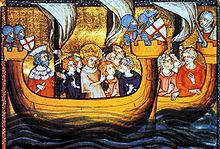
Back الحملة الصليبية السابعة Arabic الحمله الصليبيه السابعه ARZ Séptima cruzada AST یئدینجی صلیبی ساواشی AZB Сёмы крыжовы паход Byelorussian Седми кръстоносен поход Bulgarian সপ্তম ক্রুসেড Bengali/Bangla Seizhvet Kroaziadeg Breton Sedmi krstaški rat BS Setena Croada Catalan
| Seventh Crusade | |||||||||
|---|---|---|---|---|---|---|---|---|---|
| Part of the Crusades | |||||||||
 Louis IX during the Seventh Crusade | |||||||||
| |||||||||
| Belligerents | |||||||||
|
|
| ||||||||
| Commanders and leaders | |||||||||
| Strength | |||||||||
|
15,000 infantry 2,400–2,800 knights 5,000 crossbowmen | Unknown | ||||||||
| Casualties and losses | |||||||||
|
Heavy
|
Heavy
| ||||||||
The Seventh Crusade (1248–1254) was the first of the two Crusades led by Louis IX of France. Also known as the Crusade of Louis IX to the Holy Land, it aimed to reclaim the Holy Land by attacking Egypt, the main seat of Muslim power in the Near East. The Crusade was conducted in response to setbacks in the Kingdom of Jerusalem, beginning with the loss of the Holy City in 1244, and was preached by Innocent IV in conjunction with a crusade against emperor Frederick II, Baltic rebellions and Mongol incursions. After initial success, the crusade ended in defeat, with most of the army – including the king – captured by the Muslims.
Following his release, Louis stayed in the Holy Land for four years, doing what he could towards the re-establishment of the kingdom. The struggle between the papacy and Holy Roman Empire paralyzed Europe, with few answering Louis' calls for help following his capture and ransoming. The one answer was the Shepherds’ Crusade, started to rescue the king and meeting with disaster. In 1254, Louis returned to France having concluded some important treaties. The second of Louis' Crusades was his equally unsuccessful 1270 expedition to Tunis, the Eighth Crusade, where he died of dysentery shortly after the campaign landed.
© MMXXIII Rich X Search. We shall prevail. All rights reserved. Rich X Search